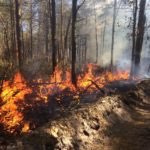The message was clear, after spending three days at the recent “Fire in Eastern Oak Forests Conference”, we need more fire in oak forests! Although possibly a jarring statement to the general public, this takeaway was fleshed out in detail on how prescribed burning can be an important tool to manage oak forests, the most common forest type in northern New Jersey. Regional experts, including land managers, academics and other conservation professionals, presented the latest fire science to over 250 attendees representing 28 states throughout the east. Presentations explored the historical role that fire has played in shaping eastern oak forests, and we learned about the unexpected negative implications on forest health after 75 years of fire prevention advocacy by Smokey Bear. More importantly, we discussed how to safely expand the use of prescribed fire to reverse these trends and restore habitats that have declined.
Forest ecologists presented how prior to European settlement, wildfire was a primary disturbance factor that naturally diversified forests to support a wide variety of wildlife. In fact, most research suggests that fire repeatedly occurred in New Jersey’s oak forests every 10-20 years. At this frequency, forests of the past would have looked much differently than they do today. As patches of trees would succumb to fire, significant canopy openings would emerge that supported sun-loving grasses, forbs, shrubs and young trees, many of which could withstand drier conditions resulting from fire. Contrast that to today, where the most significant natural disturbance is wind toppled trees that happen during rainstorms. Under a wind disturbance pattern, canopy openings tend to be smaller and skewed towards promoting moisture loving plants that do best in partial shade, which slowly converts oak forests to different plants groups that don’t support the same insects or wildlife that evolved in the oak forests. Recently, this process has been termed “mesophication”, which basically means the s

Leaves of oaks are host plants for the Polyphemus moth. Photo by John Parke
upplanting of dry plant communities by those that prefer additional moisture and shade. Unfortunately, many of the “mesic” species like maple tend to be less critical components of the food web than oaks are. For example, according to University of Delaware Professor Doug Tallamy, oaks support more than 530 lepidoptera (moths and butterflies) species while maples host 285. Considering that acorns are also far more valuable as a wildlife food source than maple seeds, it’s easy to see how losing oak from the forest will affect forest health.
Another untapped benefit of using prescribed fire may be to control invasive plants in the forest. New Jersey Audubon has been using fire this way, and now with the recent passage of the Prescribed Burn Act, there will be more opportunities to control invasive plants using fire.

NJA stewardship staff joined the New Jersey Forest Fire Service on a private property to conduct a burn in Spring of 2019
After seeing the positive results of prescribed fire at field locations during the conference and learning the substantial body of science supporting it, we were eager to return to New Jersey to continue promoting and using prescribed fire here. Fortunately, because of the long-term research and field application of prescribed fire that has been established over decades in other nearby states, we can capitalize on their experiences and begin using fire as a tool for healthy forests more quickly.
Interested in reading more about the effects of fire in oak forests? Hundreds of publications and research papers regarding fire in oak ecosystems were synthesized into a comprehensive publication available through the US Forest Service. Both digital and physical copies are available: https://www.nrs.fs.fed.us/pubs/46252.










